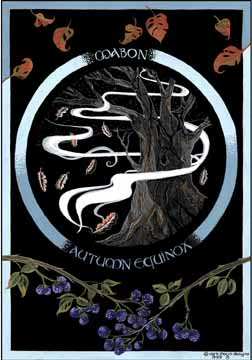
“Blessed be, by the Lady and the Lord, on this Mea’n Fo’mhair. It is the time of the second harvest, one of fruit and wine abundance. Tonight holds equilibrium of all things. Everything is in balance with one another. God and Goddess, Life and Death, Light and Dark.”Immortal Boundaries, Aubrey Jones
References to the Welsh god Mabon ap Mydron (Mabon, Son of Modron, or ‘Great Son of the Great Mother’) date back well over a thousand years. Today the name Mabon conjures up images of ancient Celtic rituals, of the fruits of the harvest, of flickering flames beneath an autumn moon. So you may be surprised to learn that ‘Mabon’—in reference to the autumnal equinox—dates not to the Dark Ages, but to the Disco Age (a dark age in its own right), the 1970s.
The holiday Mabon was coined by a grad student, Aidan Kelly, as part of a religious studies project. Kelly was following the Celtic and pagan tradition of naming holy days after gods and goddesses. Lughnasadh honors the Irish sun god Lugh. Beltane is believed to originate from Ba’al. The spring equinox is named for the German goddess Ostara, from which our word Easter also derives.
There was a holiday known as “Mabon’s Day” in Wales in the 19th century. But that holiday was named for William “Mabon” Abraham, a labor leader responsible for improving miners’ working conditions in Wales, (Mabon is a colloquialism for “young leader” in Welsh) and took place on the first Monday of each month.
Since the 1970s, the autumnal holiday Mabon has gained wide acceptance as a Wiccan and neo-pagan celebration in North America. The Celts, however, didn’t observe the autumnal equinox as much as the cross-quarter days of Lughnasadh (early August) and Samhain (Halloween), the latter of which was Celtic New Year.
The “Second Harvest” is known by many names: Cornucopia, Wine Harvest, Harvest Home, and the Feast of Avalon.
Avalon, one of the many Celtic names for the Land of the Dead, literally means the “land of apples…Celebrating new-made wine, harvesting apples and vine products, and visiting burial cairns to place an apple upon them were all ways in which the Celts honored this Sabbat.
Edain McCoy, Celtic Myth & Magick
It’s a joyous celebration, but whereas the spring festivals celebrate birth and fertility, at the time of the harvest, Mabon participants remember their ancestors.
A similar tradition exists in Japanese culture. On the equinox, the Japanese visit the graves of their ancestors. It is known as O-higan, or “the Other Shore.” Buddha is said to walk the earth when night and day are equally divided.
Mabon is also known by variants of Fomhair. In Gaelic, the months of September and October are the only two to share a name: Mi Mean Fomhair and Mi Deireadh Fomhair: mid-harvest month and end-harvest month.

